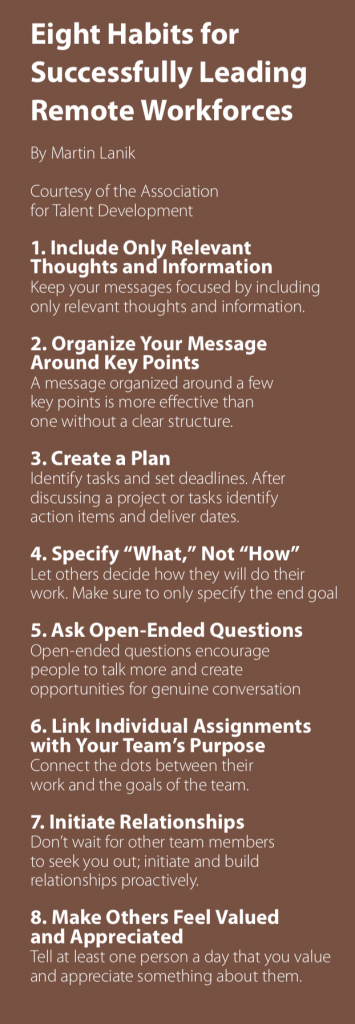A pandemic, remote work and ‘the new normal’
The COVID-19 pandemic has upended nearly every aspect of our society – including the way local government workforces perform their day-to-day operations. The virus forced employees out of their offices and into their homes. Essential workers have staggered their shifts and limited their interaction with the public and each other. Remote work has become the norm, and virtual service delivery has become critical, leaving many communities scrambling to digitize services.
However, the pandemic might also be an opportunity to reassess the way we think about the way the work of local government is performed. Questions of how, why and where abound. One thing is for certain, though, this is a turning point for government, and it’s up to local leaders to determine what the new normal will look like.
The importance of policy
The workplace policies most local governments] had in place prior to the pandemic were really meant for in-person engagements Ryan Park, state and local government marketing manager at Laserfiche, says. “As the shift to remote work has taken place, it’s definitely caused a disruption in being able to effectively and collaboratively work from home.”
However, despite these dramatic changes in how and where the work is being performed, it’s still the ultimate goal of local government to provide programs and services to their residents as efficiently as possible and at the best return on investment for their tax dollars, Jason Grant, director of advocacy at the International City/County Management Association, says. Although the current situation has necessitated less face-to-face interaction, the work of local government still needs to be accomplished – we don’t have the luxury of closing up shop to wait this out, he says.
While there are no one-size-fits-all approaches to these workforce transitions, it’s important to ask how we will manage the needs of the people and protect local government employees while following the guidance coming from the leaders in the state and federal governments as well as the scientific community, Grant says. This balancing act should be at the core of every decision made during the pandemic.
With this in mind, Grant says there are a lot of opportunities for re-imagining how local governments accomplish their work, and various communities are approaching the challenges differently. “Some immediately implemented telework, some didn’t. For some it was necessary, for some it wasn’t,” he says. Some communities were better prepared for this transition than others – they had the IT infrastructure in place, they had the crisis management plans written. “The challenges or obstacles will be different from locality to locality,” Grant adds.
However, that doesn’t mean there aren’t best practices for managing decentralized teams. For these lessons, it’s helpful to look at both private and public sector entities that were implementing remote work structures before the pandemic.
The transition to telework and virtual service delivery
 “If you’re going to use telework, there are certain things you need to have in place,” Grant says. “One is your management practices and your personnel policies.” During this period of transition, these policies must be clearly defined, and they need to be robust. Employees need to have defined communication paths to their supervisors; they need to know how they will be submitting deliverables in the new virtual environment. Expectations need to be clear, and communication needs to be open and frequent.”
“If you’re going to use telework, there are certain things you need to have in place,” Grant says. “One is your management practices and your personnel policies.” During this period of transition, these policies must be clearly defined, and they need to be robust. Employees need to have defined communication paths to their supervisors; they need to know how they will be submitting deliverables in the new virtual environment. Expectations need to be clear, and communication needs to be open and frequent.”
Ryan Changcoco, head of management development and industry verticals at the Association for Talent Development, adds that once the process is identified for how work gets done, it is important to set expectations and guidelines for discussing and sharing milestones. “Managers and leaders should set meetings dedicated to discussing these milestones and expectations, Changcoco says. Additionally, implementing project management tools that you can share with your direct reports, such as Trello, Asana, Monday, or MS Project. Something as simple as a shared spreadsheet can help keep everyone on the same page with regards to projects and important deliverables.”
Communication is also critical, Changcoco says. “In a virtual work environment, impromptu meetings, office drop-ins, and hallway conversations are not an option. However, consistent communication is still key to setting expectations and making a virtual arrangement work for teams,” he explains. “As the team’s manager, it is up to you to determine the proper channels that your team should use for effective communications. There are many technology solutions to help bridge the connection gap, and when all else fails, there is no reason not to go old school and pick up the phone and place a call or send a text.”
Grant also cautions that just because someone might be working from a remote location, that doesn’t relieve their department from their legal and regulatory responsibilities as an employer. “If someone needs accommodations, those accommodations need to be met in some way. If someone is teleworking, that doesn’t mean there aren’t any obligations for the local government…” Grant says. “There are basic operational and policy items that need to be put in place first to manage operations.”
The pandemic, however, has necessitated making these changes on much tighter timelines than normal. This means there needs to be some level of prioritization. Beyond having strong personnel policies in place, Grant suggests considering the best use of IT resources and the security of connections between employees. “What you need to prioritize will be dependent on your particular situation,” he says. “Different communities are in different phases of this.”
Training during this process, however, is critical. Russell Narahara, management analyst for Laguna Niguel, Calif., says using virtual platforms to train city employees is crucial for the success of work-from-home programs and helping to transition critical services into virtual spaces.
“It has been a challenge,” Narahara says. “It’s a challenge to actually deploy these solutions and train staff to use them. How we’re accomplishing that is using remote platforms. Where we would typically have a kick-off meeting with all the city staff in one location, we’re starting to record videos to show how solutions work.”
These video training modules are short, and deal with one concept at a time, Narahara says. Instead of giving employees hours of training materials, they are presented with what they need to know when they need to know it. While this hasn’t made the transition seamless, it’s certainly made it easier.
And while the adaptation of new technology to maintain productivity is difficult, Changcoco says it’s not the only hurdle.
“The key to a successful transition is more about finding and sticking to a process that works for them to maintain productivity, Changcoco says. “It’s important for people to understand that the fluidity of the at-home workday will have way more peaks and troughs because of the personal challenges that many face.”
Offering advice to leaders going through this transition, Changcoco says it’s important to be nimble and flexible. “Focus on setting expectations, over-communicating, and connecting,” he says. “Be hyper-aware about not being in the office and do your best to listen intently. When doing meetings or check-ins, try to use the video function if that is something that you are open to. It helps with reading facial expressions and body language.”
The new normal
“I think by and large in society – government, private sector – you’re going to see a shift,” Grant says, explaining that for the past few months, people have been forced to live in a more online world. Adjusting to this “new normal” might impact the way these people want government to deliver services. This might be an opportunity for local governments to adapt to the changing demands of the constituents they serve.
Additionally, Grant says that while there is a desire to return to a pre-pandemic normal, remote work has been successful. “Most of what we’re hearing now is that those jobs that have transitioned to telework have been working well,” he says. There’s not a rush to reopen buildings and get employees back to perform the functions of government – the adoption of remote work has pretty successfully bridged the gaps where it was needed. “I think you will see governments asking, “what does that new normal looks like?”” he adds. “For some, there will be increased teleworking.”
The future of increased telework might be inevitable, but Changcoco says that doesn’t mean it will be overly disruptive to government processes. “Process and structure are the backbone of success for all work environments, both in-person and virtual,” he says. “Transitioning to the “new normal” does not mean that you must re-invent the wheel. It means that you need to modify it to better suit your vehicle.”
For Park, that means acting on the opportunity to bring face-to-face interaction into the virtual space. “Through this disruption, a lot of essential services that were designed for in-person meetings can be brought online and made virtual,” he says. “This is how we keep civic life going during the pandemic and beyond.”
The human element
It’s easy to think of governmental operations as faceless, monolithic tasks that must be accomplished, but in these times it’s particularly important to remember the work of local government is performed by people. These are people with friends and families, hopes and dreams, fears and anxieties. Change is challenging for people, and it’s especially difficult when the impetus of that change is a global health crisis. Managers, department heads and team leads need to be cognizant of this and practice empathy wherever possible.
“Managers need to reach out to their staff to have one-on-one conversations with them to make sure they’re heard,” Grant says. They need to ask their employees what their needs are, what their concerns are and how the team can adjust to make them feel both productive and secure. “It’s on managers to reach out – to have those real conversations with people,” he says, adding that many local governments have assistance programs available – mental health or otherwise. It would be a good idea for leaders to familiarize themselves with what their organizations offer so if a team member is struggling, they can get the help they need.”
Managers need to realize that their team members are under extreme stress, Changcoco says, so it’s important to watch out for signs of burnout. “The lack of connection due to social distancing can take a toll on people,” he says. “Pair this with personal challenges faced at home and the overall changes that are happening at work; this is a formula that causes a great deal of stress on any individual.”
The positives in a pandemic
These are unprecedented times. These are challenging times, and for far too many, these are terrible times. However, that doesn’t mean these times are hopeless.
One of the silver linings, Narahara says, is that this is an opportunity to take a hard look at the way we do things in local government and ask tough questions about those processes. The pandemic has been disruptive to the idea of “this is how we’ve always done it,” and it’s a chance to rethink entrenched processes.
Ultimately though, for Grant, the positive takeaway here is the continued willingness of local government leaders and employees to rise to the occasion. “The biggest thing you see is local governments striving to continue serving their communities,” he says. “We’re still meeting the needs of the people. That’s what we do.”





















